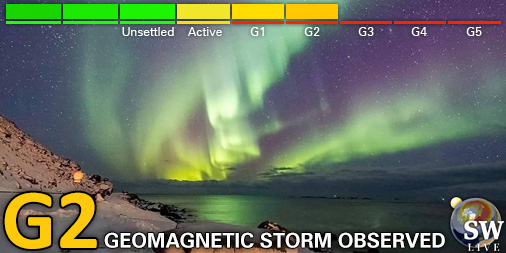Viewing archive of Tuesday, 8 January 2019
Daily bulletin on solar and geomagnetic activity from the SIDC
Issued: 2019 Jan 08 1230 UTC
SIDC Forecast
Solar flares
Quiet conditions (<50% probability of C-class flares)
Geomagnetism
Quiet (A<20 and K<4)
Solar protons
Quiet
| 10cm flux | Ap | |
|---|---|---|
| 08 Jan 2019 | 071 | 003 |
| 09 Jan 2019 | 070 | 004 |
| 10 Jan 2019 | 070 | 004 |
Bulletin
The solar activity has been quiet over the past 24 hours. The visible solar disc remained spotless, and no significant flare has been recorded. Quiet flaring conditions are expected for the next 24-hour period.
No Earth directed Coronal Mass Ejection has been observed. The greater than 10 MeV solar protons flux remained at nominal levels over the past 24 hours and is expected to remain so.
The solar wind parameters showed a slow return toward the ambient background and slow solar wind speed regime. The wind speed decreased from 530 to 420 km/s. Total interplanetary magnetic field strength was remaining below 6 nT. The southward magnetic component fluctuated between -5 and 5 nT. The solar wind speed is expected to continue its return toward nominal values.
The geomagnetic conditions were quiet with a short unsettled period (K-Dourbes index reached 3 on January 7 at 23:00 and 24:00 UT). The conditions are expected to remain quiet.
Today's estimated international sunspot number (ISN): 000, based on 14 stations.Solar indices for 07 Jan 2019
| Wolf number Catania | 000 |
| 10cm solar flux | 072 |
| AK Chambon La Forêt | 011 |
| AK Wingst | 007 |
| Estimated Ap | 006 |
| Estimated international sunspot number | 000 - Based on 15 stations |
Noticeable events summary
| Day | Begin | Max | End | Loc | Strength | OP | 10cm | Catania/NOAA | Radio burst types | |
|---|---|---|---|---|---|---|---|---|---|---|
| None | ||||||||||
Provided by the Solar Influences Data analysis Center© - SIDC - Processed by SpaceWeatherLive
All times in UTC
Current data suggests there is a moderate possibility for aurora to appear at the following middle latitude regions in the near future
SurgutCurrent data suggests there is a slight possibility for aurora to appear at the following middle latitude regions in the near future
Kazan, Perm, Yakutsk, YekaterinburgLatest news
Latest forum messages
Support SpaceWeatherLive.com!
A lot of people come to SpaceWeatherLive to follow the Sun's activity or if there is aurora to be seen, but with more traffic comes higher server costs. Consider a donation if you enjoy SpaceWeatherLive so we can keep the website online!

Latest alerts
17:00 UTC - Geomagnetic activity
Moderate G2 geomagnetic storm (Kp6) Threshold Reached: 16:34 UTC
15:30 UTC - Geomagnetic activity
Minor G1 geomagnetic storm (Kp5) Threshold Reached: 15:20 UTC
14:30 UTC - Geomagnetic activity
Strong G3 geomagnetic storm (Kp7) Threshold Reached: 14:18 UTC
13:30 UTC - Geomagnetic activity
Moderate G2 geomagnetic storm (Kp6) Threshold Reached: 13:21 UTC
13:18 UTC - Hemispheric Power Index
The OVATION model predicts the Hemispheric Power Index to reach 125GW at 14:01 UTC
Space weather facts
| Last X-flare | 2025/03/28 | X1.1 |
| Last M-flare | 2025/04/15 | M1.2 |
| Last geomagnetic storm | 2025/04/15 | Kp6+ (G2) |
| Spotless days | |
|---|---|
| Last spotless day | 2022/06/08 |
| Monthly mean Sunspot Number | |
|---|---|
| March 2025 | 134.2 -20.4 |
| April 2025 | 124.1 -10.1 |
| Last 30 days | 124.7 -16.6 |






